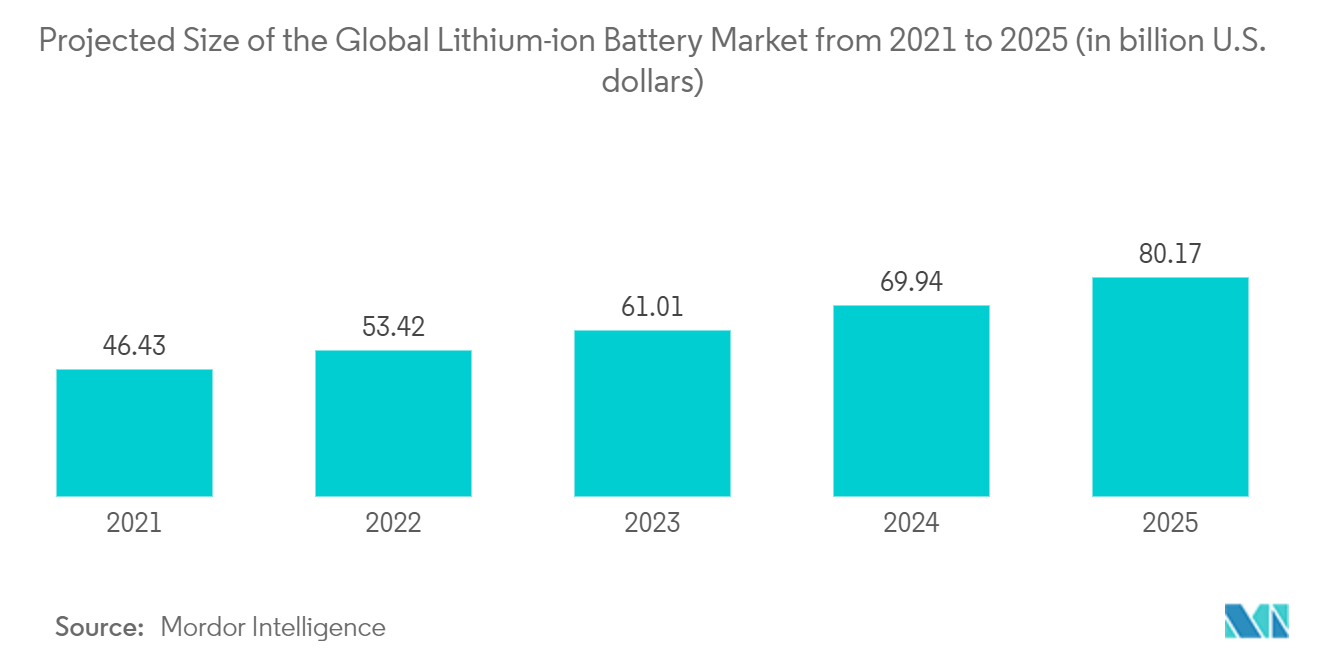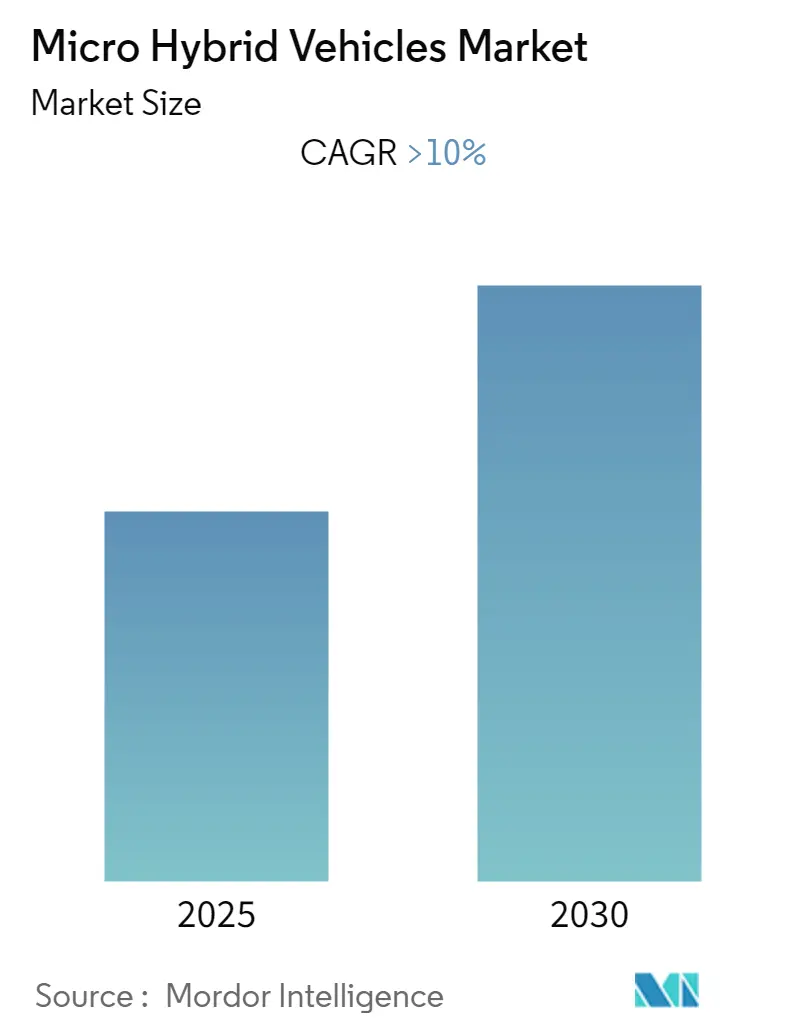
| Study Period | 2019 - 2030 |
| Base Year For Estimation | 2024 |
| Forecast Data Period | 2025 - 2030 |
| CAGR | 10.00 % |
| Fastest Growing Market | Asia-Pacific |
| Largest Market | Asia-Pacific |
| Market Concentration | Low |
Major Players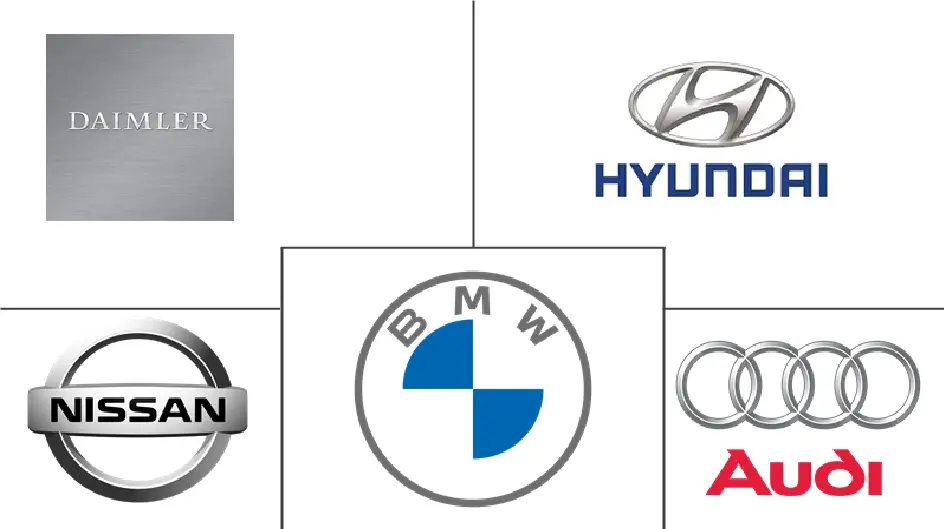
*Disclaimer: Major Players sorted in no particular order |
Micro-Hybrid Vehicles Market Analysis
The Micro Hybrid Vehicles Market is expected to register a CAGR of greater than 10% during the forecast period.
- The COVID-19 pandemic benefited the hybrid vehicle (which includes micro-hybrid vehicles) market by crystallizing attitudes toward the environment by revealing cleaner air and lowering pollution levels during the lockdown. COVID-19 raised their environmental awareness, and their concerns are now reflected in plans to purchase more environmentally friendly electric and hybrid vehicles. Manufacturers plan to launch new models to attract customers, so the forecast period is expected to be optimistic.
- Over the long term, developing high-performance lithium-ion batteries is expected to help drive the micro-hybrid vehicle market significantly during the forecast period. These vehicles have small batteries and motors that do not require any technical modification or requirements for battery manufacturing other than what is required for hybrid and electric vehicles.
- With increasingly stringent emission standards worldwide, automakers are gradually shifting production away from conventional engine vehicles to hybrid and electric vehicles. Concerns about environmental protection and reducing greenhouse gas emissions, particularly carbon dioxide, will significantly drive market growth. However, the high cost of hybrid and electric vehicles and a need for charging infrastructure may slow market growth, as cost-conscious customers prefer conventional IC engine vehicles.
- Moreover, rising consumer vehicle sales in developing economies such as India and China present massive growth opportunities for the micro-hybrid vehicles market. In these countries, the growing population of people with high disposable incomes and a willingness to spend more on environmentally friendly automobiles is compelling car manufacturers to introduce micro-hybrid vehicles. In the coming years, hybrid technology is expected to account for a significant portion of total car sales in these countries.
Micro-Hybrid Vehicles Market Trends
Increasing Demand for Lithium-ion Batteries
- Currently, the lithium-ion battery segment is experiencing more demand and is projected to be the fastest-growing battery type in the upcoming years, mainly due to the increasing sales and demand for battery electric vehicles. However, electric vehicles are causing a restraint in the market, but their growing sales drive the market. Also, stringent emission standards, better fuel efficiency, and government incentives are a few significant factors driving this segment. Battery manufacturers are partnering with OEMs, and this is, in turn, increasing vehicle sales as well.
- Most of the Asian-Pacific region's governments, such as China, Japan, and Singapore, have lifted taxes or given a considerable amount of tax exemption on purchasing EVs. These government initiatives have attracted many customers to buy EVs and are attributed to the increasing sales of Lithium-ion batteries.
- For instance, in September 2022, the announcement on Continuing Tax Exemptions on Purchases of New Energy Vehicles was jointly issued by the Ministry of Finance (MOF), the State Taxation Administration (STA), and the Ministry of Industry and Information Technology (MIIT). Purchases of new energy vehicles (NEVs) made between January 1, 2023, and December 31, 2023, will be exempt from vehicle purchase tax indefinitely, according to the announcement.
- While internal combustion engine vehicles continue to dominate, electrification in the form of start-stop and micro-hybrid vehicles has already captured a sizable market share. By 2030, approximately 60% of new cars worldwide are expected to be micro-hybrid, with close to 80% in Europe and 75% in the United States. Over the last ten years, lead battery performance has improved significantly, resulting in widespread use in start-stop and micro-hybrid applications. Furthermore, rapid industrialization and technological advancements are propelling the micro-hybrid vehicle market.
- Thus, the increasing demand for lithium-ion batteries and such developments shall lead this segment to experience more demand.
Asia-Pacific is Expected to Gain Highest Market Share
- Across the regions in Asia-Pacific, China holds a significant share in the hybrid vehicles market share owing to their highest vehicle sales. This can be attributed to their increasing population catering to the growth in vehicle sales and stringent government emission norms. For instance, the Chinese government is implementing China 6 norms for pollution control in the region which are stricter than previous China 5 norms and are based on EURO 6 norms, from July 2020, which results in supporting the demand for micro-hybrid vehicles in this region.
- Customers who purchase electric and hybrid vehicles in China are eligible for various subsidies (tax breaks and incentives). The Chinese government also announced measures to help the new energy vehicle (NEV) industry, which has been hard hit by the COVID-19 outbreak, by extending tax breaks and subsidies that were set to expire in 2020 and hinting at new investments that could boost the country's hybrid electric vehicle market in the long run.
- Vehicle manufacturers such as Toyota and Honda have dominated the hybrid vehicle segment in China, with their models such as Toyota Corolla Hybrid and Honda Accord Hybrid.
- In 2021, approximately 603,000 plug-in hybrid vehicles were sold in China, a 140 percent increase over the previous year. Also, the demand for EVs and plug-in hybrids is expected to decrease widely as their subsidies are reduced. Also, electric vehicle battery manufacturers have been signing contracts or deals with other Chinese battery manufacturers due to the increasing sales of electric and hybrid vehicles.
- For instance, in December 2022, GAC Group and China Southern Power Grid Technology Co., Ltd. (CSPGT) signed a strategic cooperation agreement for future collaboration in the energy eco-industrial chain. By focusing on constructing a new energy ecology and leveraging their respective strengths and proprietary technologies, the two parties will conduct business cooperatively in new energy storage, microgrid, and battery recycling.
- Moreover, the Indian government has also announced that all the vehicles registered after April 1st of 2020, should be BS-VI compliant. However, due to the outbreak of COVId-19 in the country, dealerships and production facilities were shut down from mid-march, due to which large stock of BS-IV vehicles have been in the inventory. The government has given an extension. This will certainly boost the market post the end of the lockdown in the country.
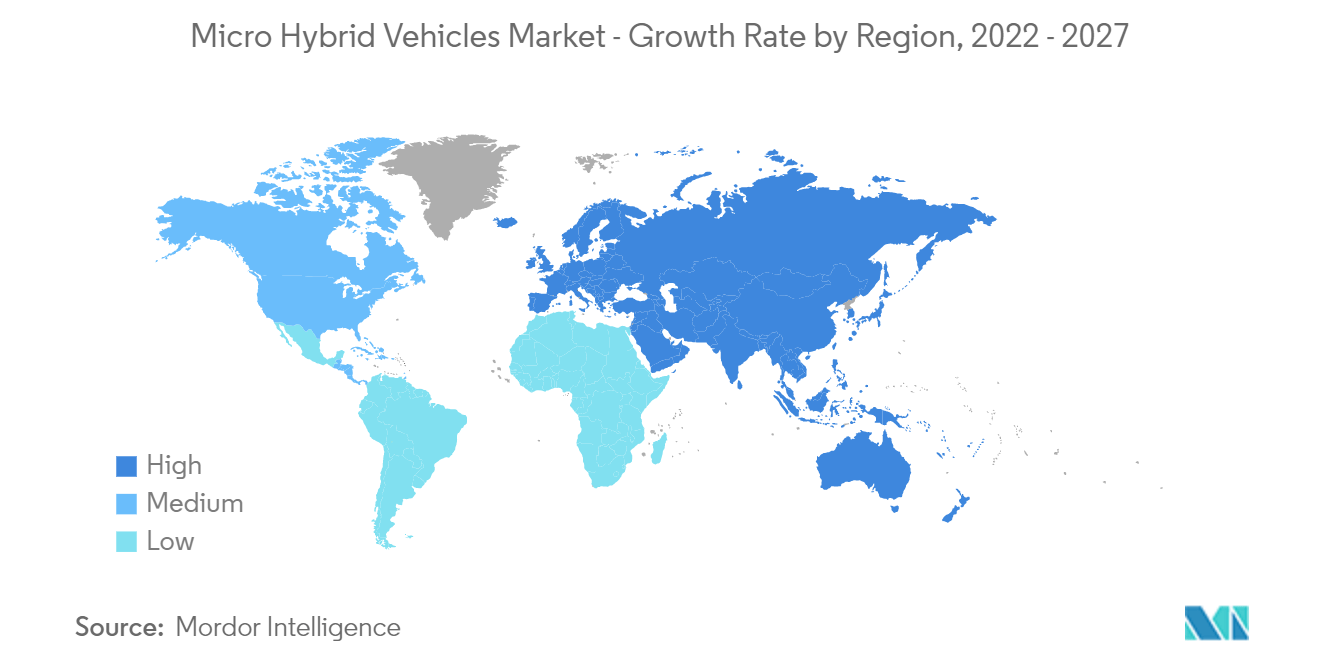
Micro-Hybrid Vehicles Industry Overview
The Micro-Hybrid Vehicle Market is dominated by various international and regional players such as Audi AG, BMW AG, DAIMLER AG, SUBARU, and General Motors. Although it has an edge over its competitors, the major automotive micro-hybrid vehicle companies are making joint ventures, and partnerships to launch newer products.
These vehicles are in their early stages, and advanced features such as keeping the air conditioning running while the engine is off and shutting off the engine while coasting are included. Rapid technological advancements are thus expected to boost the global micro-hybrid vehicle market growth during the forecast period.
Micro-Hybrid Vehicles Market Leaders
-
Daimler AG
-
Hyundai Motors Company
-
Nissan Motor Corporation
-
BMW
-
AUDI AG
- *Disclaimer: Major Players sorted in no particular order
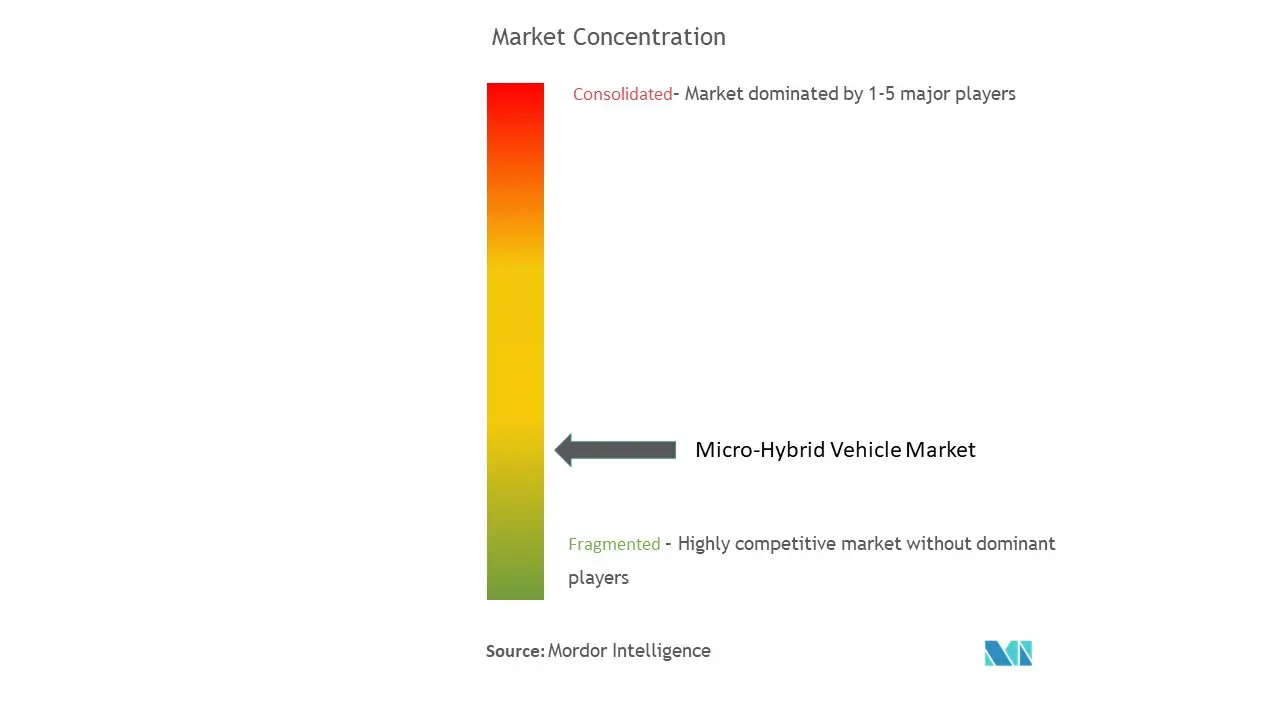
Micro-Hybrid Vehicles Market News
- September 2021: Birla Carbon announced its entry into the energy systems market by participating in The Battery Show 2021 in the United States. Demand for higher-performance lead acid batteries is increasing as automakers strive to meet more stringent CO2 emission requirements, particularly for start-stop or micro-hybrid vehicles.
- May 2021: Renault announced the Clio E-TECH Hybrid, Captur, and Megane Estate E-TECH Plug-in Hybrid. It is expanding its hybrid lineup with the introduction of three new hybrid vehicles. In addition to the full hybrid, the New Renault Arkana and New Captur introduce a 12V micro-hybridization solution on the 1.3 TCe 140 and 160 petrol engines, a first for Renault.
Micro-Hybrid Vehicles Industry Segmentation
Mild hybrids, also known as micro hybrids, use a battery and an electric motor to help power the vehicle and allow the engine to shut off when the vehicle stops (for example, at traffic lights or in stop-and-go traffic), improving fuel economy even further.
Micro-hybrid vehicle market has been segmented by capacity (12v micro hybrid and 48v micro hybrid), vehicle type (passenger cars and commercial vehicles), battery type (lead-acid and lithium-ion), and geography (North America, Europe, Asia-Pacific, and Rest of the World).
The report offers market size and forecasts for the automotive fuel filter market in value (USD billion) for all the above segments.
| Capacity | 12 V MicroHybrid | ||
| 48 V Micro Hybrid | |||
| Vehicle Type | Commercial Vehicle | ||
| Passenger Cars | |||
| Battery Type | Lithium Ion | ||
| Lead Acid | |||
| Geography | North America | United States | |
| Canada | |||
| Rest of North America | |||
| Europe | Germany | ||
| United Kingdom | |||
| France | |||
| Italy | |||
| Rest of Europe | |||
| Asia Pacific | India | ||
| China | |||
| Japan | |||
| South Korea | |||
| Rest of Asia-Pacific | |||
| Rest of the World | Brazil | ||
| Mexico | |||
| South Africa | |||
| Other Countries | |||
Micro-Hybrid Vehicles Market Research FAQs
What is the current Micro Hybrid Vehicles Market size?
The Micro Hybrid Vehicles Market is projected to register a CAGR of greater than 10% during the forecast period (2025-2030)
Who are the key players in Micro Hybrid Vehicles Market?
Daimler AG, Hyundai Motors Company, Nissan Motor Corporation, BMW and AUDI AG are the major companies operating in the Micro Hybrid Vehicles Market.
Which is the fastest growing region in Micro Hybrid Vehicles Market?
Asia-Pacific is estimated to grow at the highest CAGR over the forecast period (2025-2030).
Which region has the biggest share in Micro Hybrid Vehicles Market?
In 2025, the Asia-Pacific accounts for the largest market share in Micro Hybrid Vehicles Market.
What years does this Micro Hybrid Vehicles Market cover?
The report covers the Micro Hybrid Vehicles Market historical market size for years: 2019, 2020, 2021, 2022, 2023 and 2024. The report also forecasts the Micro Hybrid Vehicles Market size for years: 2025, 2026, 2027, 2028, 2029 and 2030.
Our Best Selling Reports
Micro-Hybrid Vehicles Industry Report
Statistics for the 2025 Micro Hybrid Vehicles market share, size and revenue growth rate, created by Mordor Intelligence™ Industry Reports. Micro Hybrid Vehicles analysis includes a market forecast outlook for 2025 to 2030 and historical overview. Get a sample of this industry analysis as a free report PDF download.



